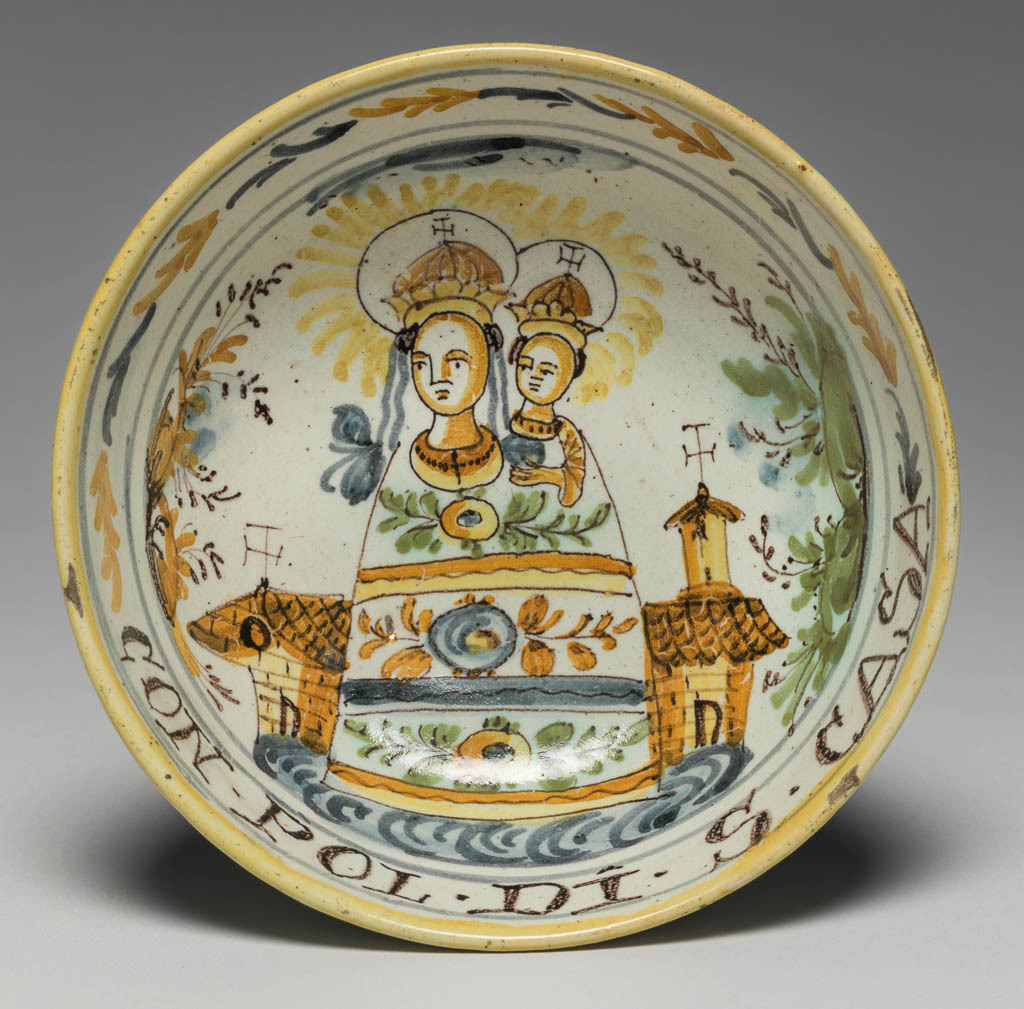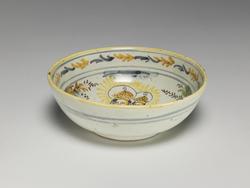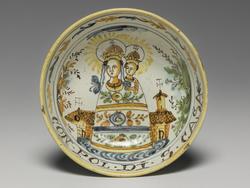Current Location: Gallery 27 (Glaisher)
Titles
Virgin and Child
Maker(s)
Maker:
Unknown
(Uncertain)
Entities
-
Bowl
- pilgrim's souvenir bowl
Categories
Description
Maiolica pilgrim's souvenir bowl, painted in polychrome with the Virgin holding the Christ Child in front of Santa Casa.
Pale yellowish-buff earthenware, tin-glazed overall. Painted in greyish-blue, sage-green, yellow, orange, brown, and manganese. Circular with curved sides, standing on a low footring.
Inside, the Virgin holding the Christ Child stands between sprays of foliage in front of the Santa Casa. Round the rim between greyish-blue lines there are alternating sprays of greyish-blue and yellow leaves, interrupted by the words `CON.POL.DI.S.CASA' (with dust of the Holy House) in manganese. Outside, there are two greyish-blue bands below the rim, which is yellow.
Notes
History note: Jolley's, Cambridge, from whom purchased on 11 July 1908 by Dr J.W.L. Glaisher for £1.10.0. (MS Cat. 2820). Jolley bought the bowl in the Corn Exchange, Cambridge. Glaisher could not remember its history in detail but thought Mr Jolley told him that it was owned by an architect from Bedford.
Legal notes
Dr J.W.L. Glaisher Bequest
Measurements and weight
Diameter: 10.9 cm
Height: 3.9 cm
Acquisition and important dates
Method of acquisition: Bequeathed
(1928-12-07)
by
Glaisher, J. W. L., Dr
Dating
18th Century
19th Century
Circa
1700
CE
-
1800
CE
Circa
1800
CE
-
1900
CE
Note
According to the legend related by Pietro Giorgio da Teramo, about 1470-3, the Virgin Mary's home at Nazareth was carried by angels to Tersatto in Yugoslavia on 10 March 1291 to save it from the Infidels. On 10 December 1294 it was moved again to a forest near Recanati but, because of brigands in the area, it was moved in August 1295 to a hilltop. This site in turn proved unfavourable because two brothers robbed the pilgrims who went there, and after one brother murdered the other, the angels transported the house to its final resting place at Loreto. During the late Middle Ages Loreto developed into an important pilgrimage centre, and a great church, completed in 1500, was built around the `house' which was encased in an elaborate marble rivestimento during the early sixteenth century. In addition to the Holy House, pilgrims came to venerate a statue of the Virgin and the Holy Bowl said to have been used by her.
Souvenir bowls for pilgrims bear the words 'CON POL DI S CASA' (con polvere di Santa Casa), referring to the adding of dust from the sweeping of the Holy House to the clay from which they were made. Bowls like this one are fairly common. The scene inside was probably copied from a woodcut on one of the printed attestations, which pilgrims acquired as evidence of their visit to the shrine. The Virgin is shown wearing a stiff robe similar to that worn by the famous statue, and stands in front of the church of the Santa Casa. Another common design is painted in baroque style, mainly in blue and yellow. The origin of most of these bowls is uncertain. Some can be attributed to Castelli, and it seems likely that the others were made near Loreto, or elsewhere in the Marches.
People, subjects and objects depicted
Components of the work
Decoration
composed of
high-temperature colours
( greyish-blue, sage-green, yellow, orange, brown, and manganese)
Materials used in production
Tin-glaze
Earthenware
Techniques used in production
Throwing
: Pale yellowish-buff earthenware, tin-glazed overall, and painted in greyish-blue, sage-green, yellow, orange, brown, and manganese.
Tin-glazing
Inscription or legends present
Inscription present: on acquisition the bowl bore a label, now missing
- Text: old majolica made from the dust of the shrine and pilgrims feet at Loretto. Very rare.
- Method of creation: Hand-written
- Type: Label
- Text: CON.POL.DI.S.CASA
- Location: On front below figures
- Method of creation: Painted in manganese
- Type: Inscription
References and bibliographic entries
Related exhibitions
Identification numbers
Accession number: C.2244-1928
Primary reference Number: 79438
Old object number: 2820
Stable URI
Audit data
Created: Saturday 6 August 2011
Updated: Monday 24 April 2023
Last processed: Tuesday 29 July 2025
Associated departments & institutions
Owner or interested party:
The Fitzwilliam Museum
Associated department:
Applied Arts

 IIIF Manifest
IIIF Manifest








